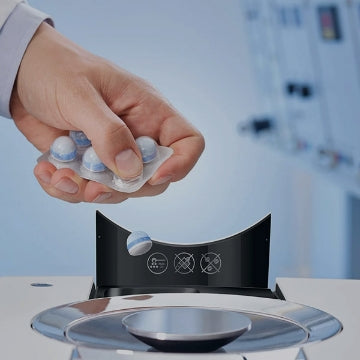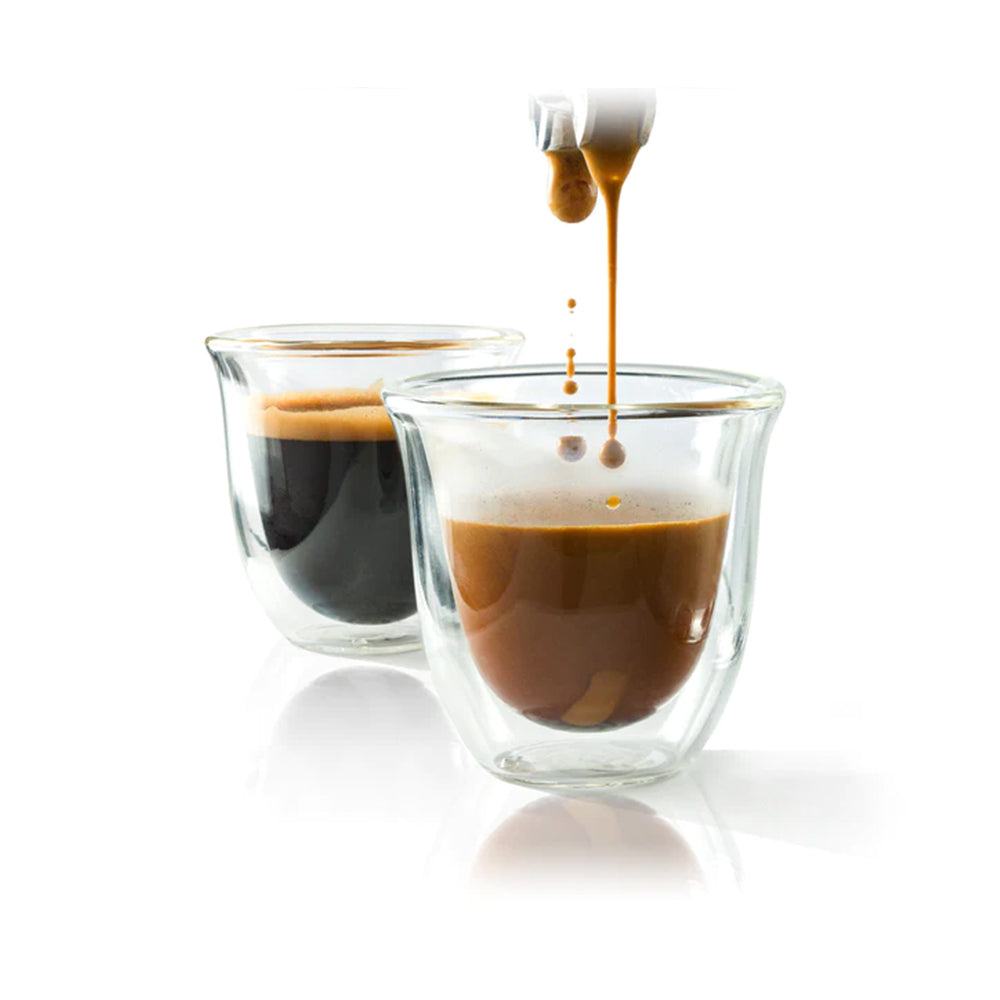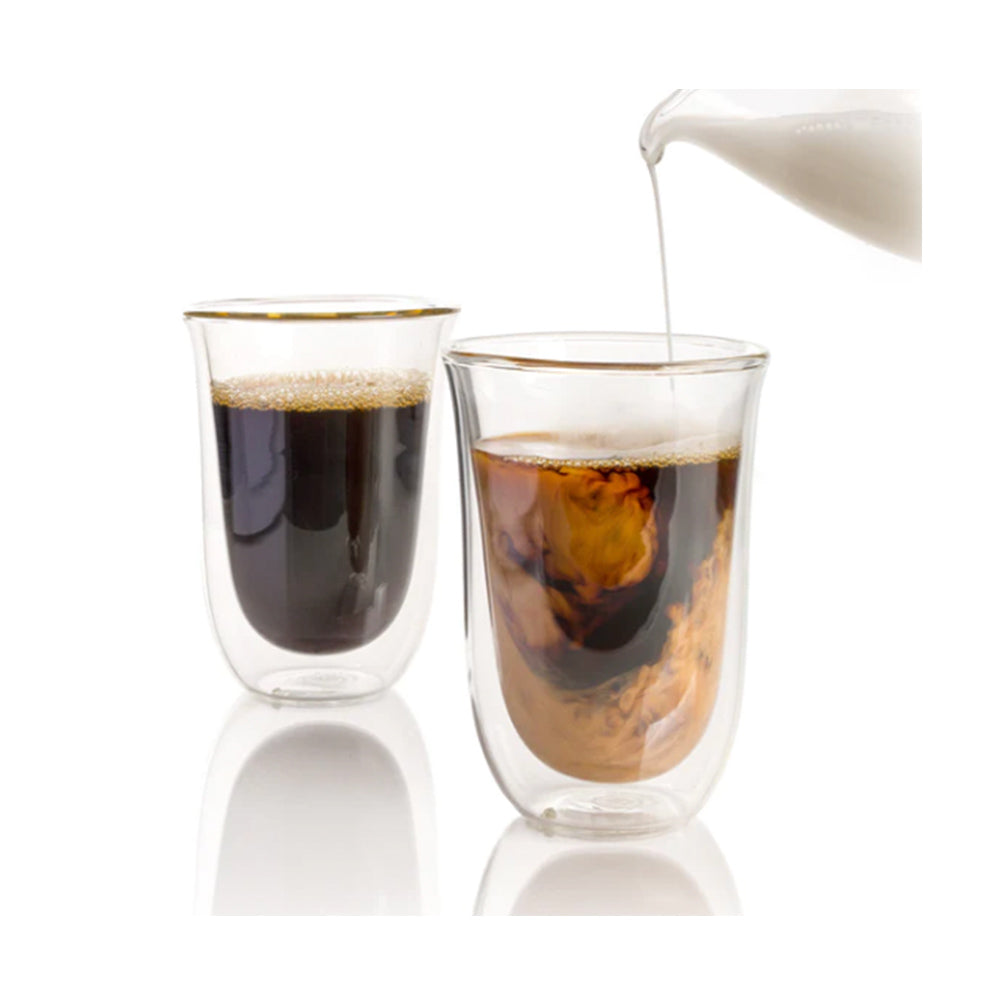

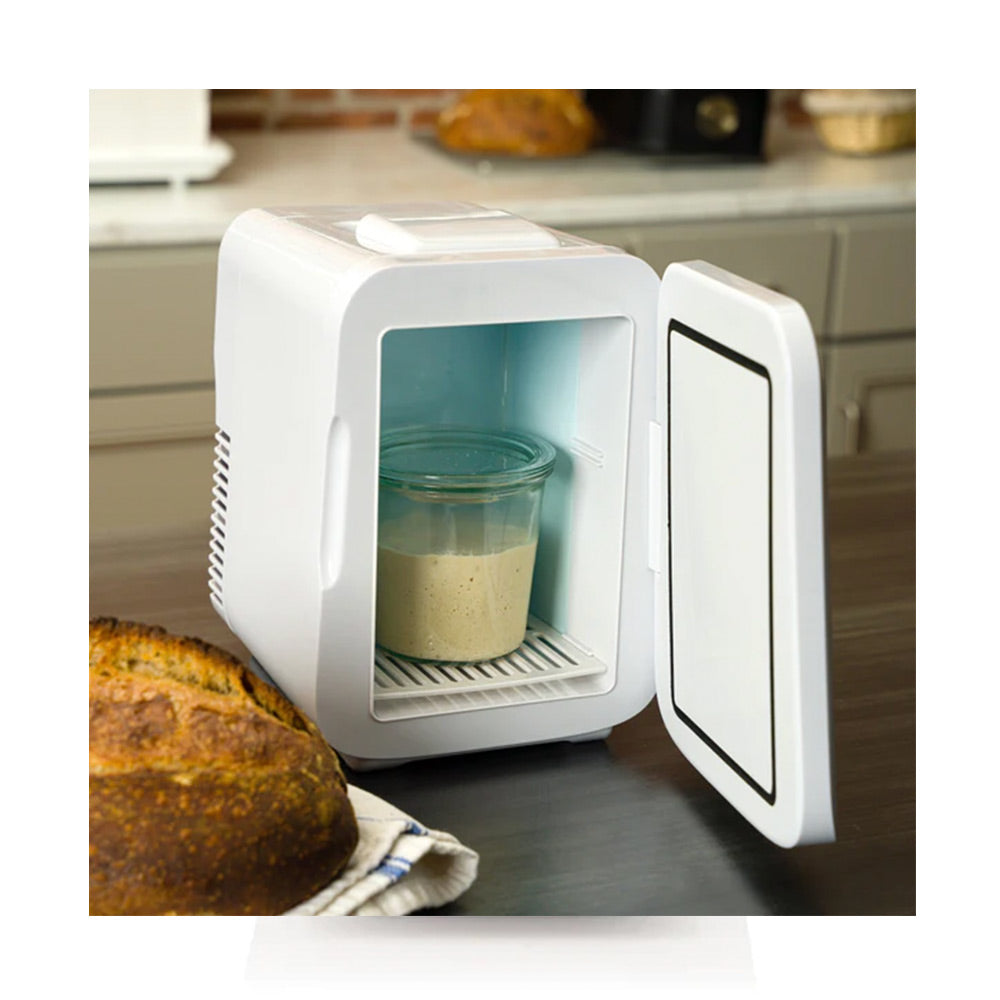
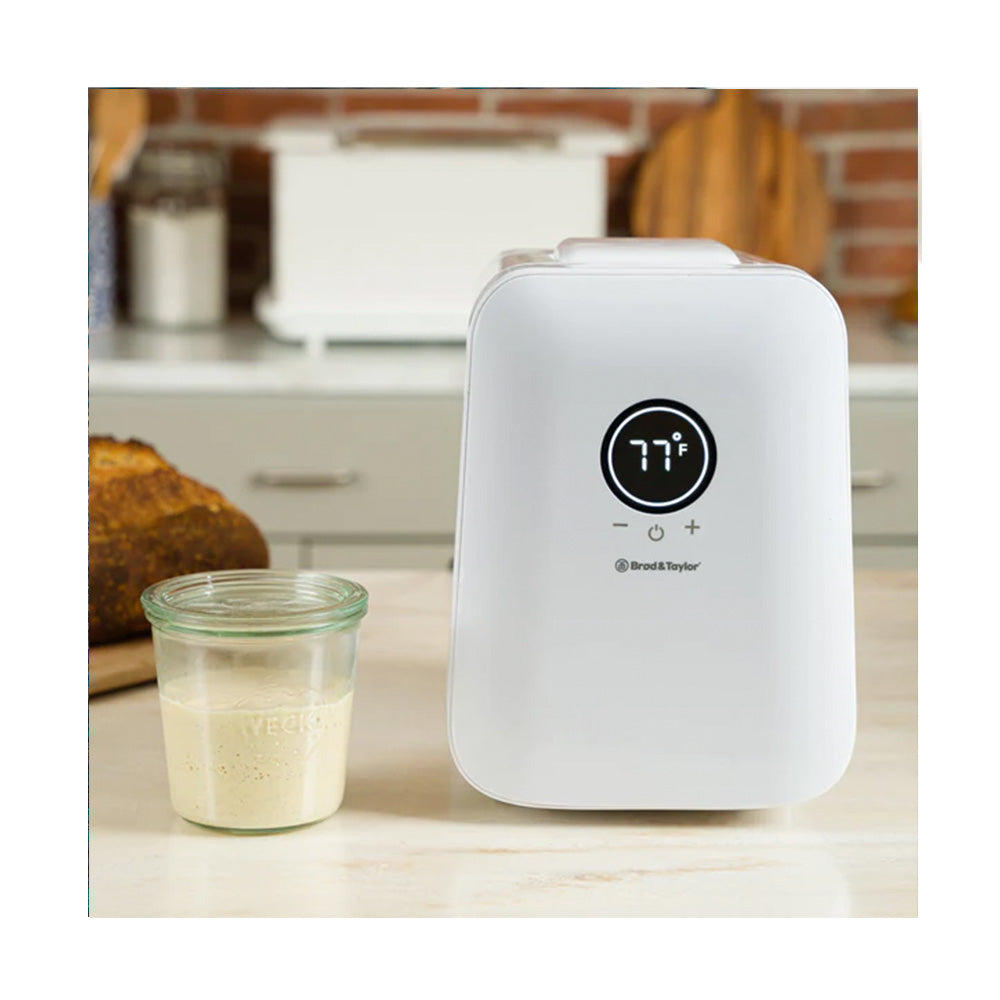
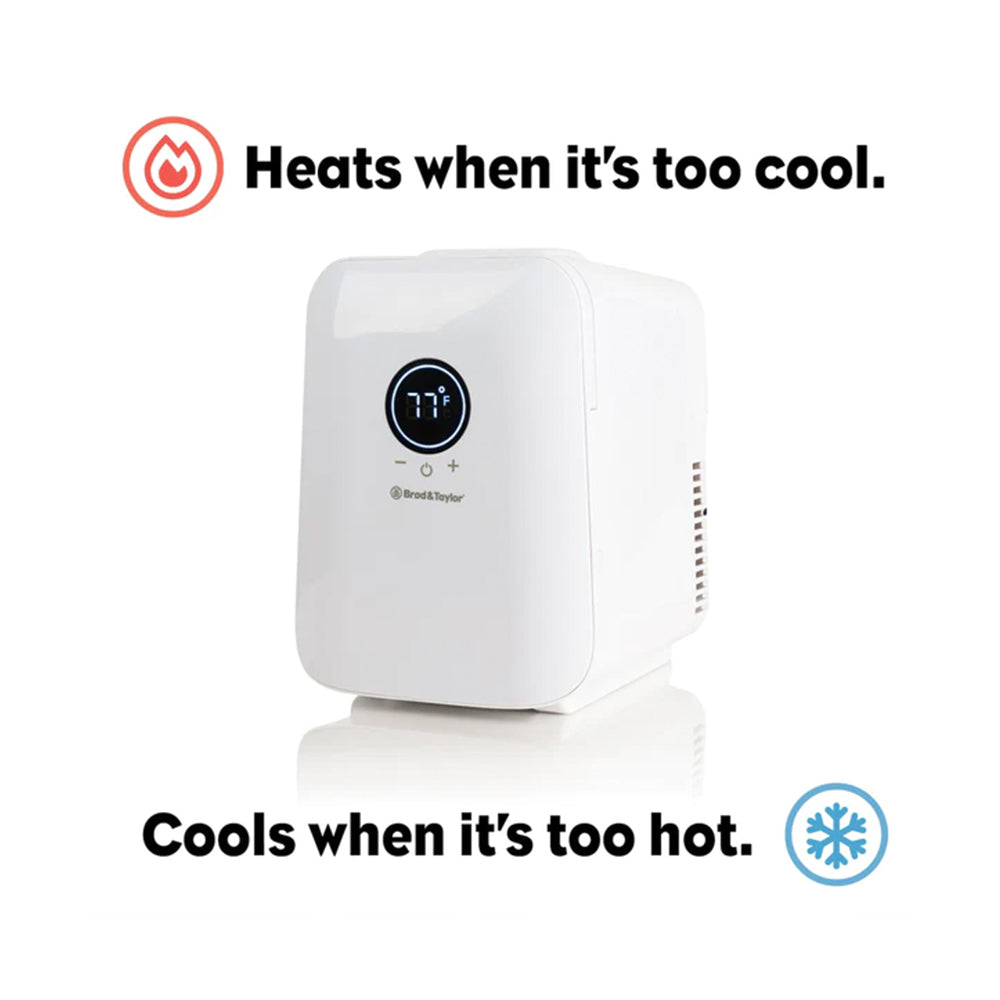

Use precise temperatures to control your starter like never before. The Sourdough Home is designed to heat or cool to keep your starter at the perfect temperature. Feed your starter on your schedule: from twice a day to once a week. Change temperature to adjust the flavor profile, aroma, and texture of your bread.
Featuring:
• Degree-by-degree setpoints from 5-50°C (41-122°F).
• Fits a single 1 quart/1 liter jar or 2 small jars.
• Two shelves for flexible storage of small items.
• Outside Dimensions: 11x8x10 in (28x23x25 cm)
• Inside Dimensions: 7.5x5⅛x5.5 in (19x13x14 cm)
• Power: 100-240V
GREAT BREAD BEGINS WITH A GREAT STARTER
When it comes to sourdough starter, temperature is everything. The complex mix of microbes that cause bread to rise - and give your bread that distinctive taste and aroma - are extremely sensitive to temperature.
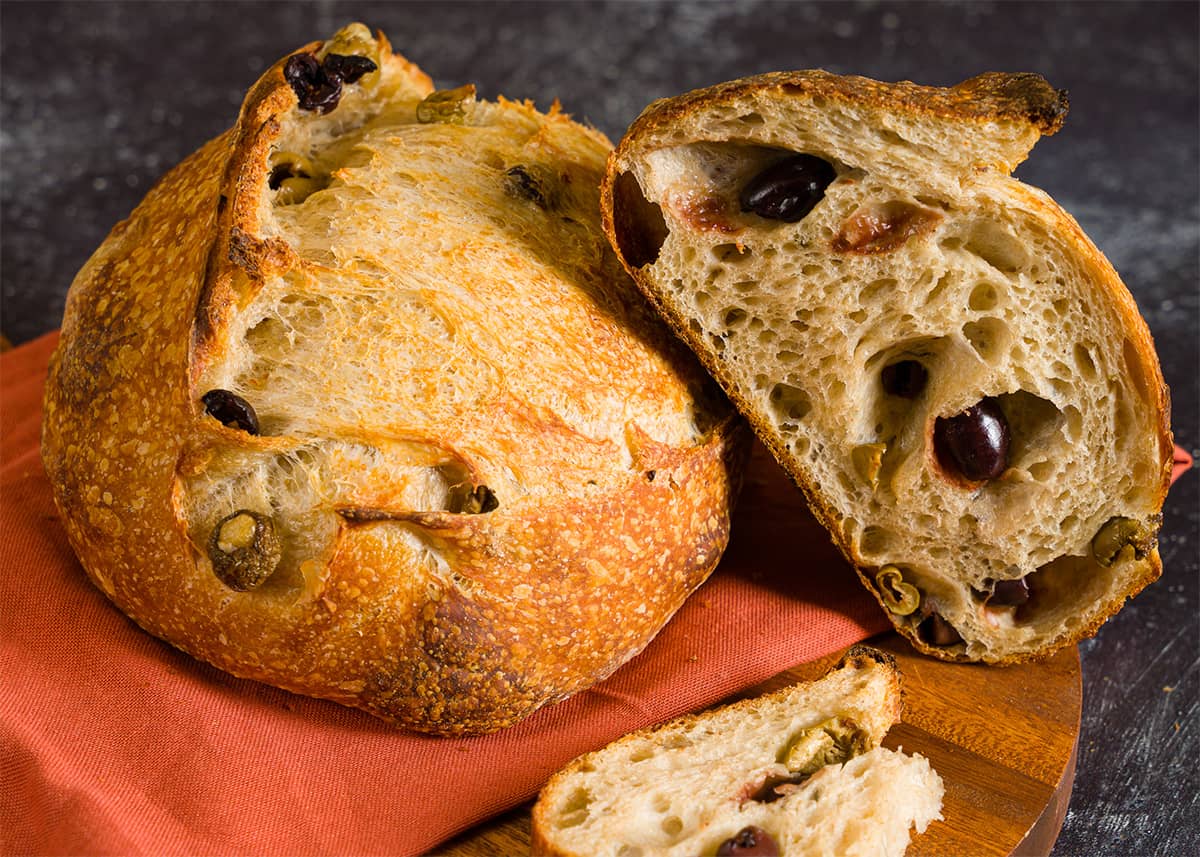
PRECISE TEMPERATURE CONTROL
Sourdough Home provides an easy way to control the temperature of your starter. With degree-by-degree temperature control from 5 - 50°C (41 - 122°F) you can maintain a consistent temperature or vary the temperature to control the growth rate, aroma, and taste of your bread.

Sourdough Starter Maintenance
Heats when it's too cool.
Cools when it's too hot.
Low power usage
Sourdough starter is a living colony of yeast and good bacteria. Like any living thing it needs to eat - just flour and water. Feeding your starter the proper ingredients at the right time is the first step in creating great sourdough bread. Using the precise temperature control of the Sourdough Home, you can adjust starter feeding times to meet your schedule.
As starter ferments and grows, it creates CO2 bubbles that cause the mixture to rise in its container. The ideal time to feed starter is when the rise has peaked - all of its food has been consumed - and before it begins to fall again. By using a constant seed ratio (quantity of flour and water) and controlling the temperature, you can control the feeding schedule to hours, days or even a week. Use the guidelines below to get started.
| Temperature | Time to Feed | Seed Ratio |
|---|---|---|
| 7°C / 45°F | 5 Days / 120 Hours | 1:4:4 |
| 10°C / 50°F | 3 days / 72 hours | 1:4:4 |
| 12°C / 54°F | 2 days / 48 hours | 1:4:4 |
| 20°C / 68°F | 1 day / 24 hours | 1:4:4 |
Seed Ratio: This is the ratio of active culture to fresh flour and water. The more active culture used, the faster your starter will grow and peak. For daily maintenance a 1:4:4 ratio will keep your starter thriving without growing too fast.
Note: Your starter may vary slightly from these results depending on the flour used and the specifics of your culture.
Brod & Taylor - Sourdough Home
Specifications
- Temperature Range: 41-122F / 5-50C
- Outside Dimensions: 11in H x 8 W x 10 D (28 x 23 x 25cm)
- Inside Dimensions: 7½in H x 5⅛ W x 5 ½ D (19 x 13 x 14 cm)
- Weight: 4.1 lbs, 1.86 kg
- Voltage: 100-240V
- Efficiency: To maintain a stable temperature, the Sourdough Home constantly adjusts the heating or cooling power. Temperature settings close to the ambient room temperature will require a very small amount of power, while temperature settings significantly above or below room temperature will require more power.
- Maximum Power Usage: Maximum power in cooling mode: 38W – maximum power in heating mode: 20W.
Warranty: 3-year Limited Warranty (with registration)
Instruction Manual
F.A.Q's
How is the Sourdough Home different from the Folding Proofer?
The Sourdough Home can both heat and cool. The Folding Proofer cannot cool meaning it cannot bring its contents below room temperature. For example, even though the temperature range of the proofer is 21 - 49°C (70 - 120°F) if the room temperature is 25°C (77°F) the Proofer will not be able to bring its contents to 21°C (70°F). The proofer is larger than the SD Home and can accommodate a large mixing bowl, bread pans, or other containers used when proofing bread dough. The Sourdough Home is smaller and designed specifically with sourdough starter in mind and can accommodate up to a 1 liter/1 quart jar.
Why should I keep my starter in the SD Home?
The health and growth rate of a sourdough starter are heavily influenced by feeding schedule (frequency) and temperature. To maintain a healthy starter ready for baking, many bakers store their starter at room temperature and refresh on a daily basis. Room temperature can fluctuate throughout the year and fermentation activity can become unpredictable and difficult to manage. Bakers often need to adjust feeding ratios and frequency to accommodate for these temperature swings. With the Sourdough Home, you can keep your starter at a consistent temperature year-round. No need to adjust ratios or feeding schedule.
What about just storing my starter in the refrigerator?
Weekend bakers may not want to feed their starter everyday- it is unnecessary and wastes a lot of flour. Often, bakers store their starter in the refrigerator as an alternative to feeding daily. However, refrigerator temperatures hover around 38°F (3°C) which is too cold for the yeast and bacteria in starter. When it is time to bake, one must give the refrigerated starter a few refreshments to get it up to full strength ready for baking. Using the Sourdough Home to store your starter is the perfect solution. By keeping your starter cool, but not cold you can slow down fermentation, while not bringing it to a complete halt. Your starter will be healthy and ready to use without additional feedings.
I don’t want to feed my starter every day. What is the recommended feeding schedule?
With the SD Home, you can create a starter feeding schedule that works for you. Feed your starter once a day, every three days, or even once a week. Precise control over a wide range of temperatures allows you to manage the fermentation rate of your starter like never before and provides the ability to control when your starter peaks. Time to peak at various temperatures will depend on seed ratio, hydration level, and type of flour used. Experiment with your own starter to get desired results. Use our guideline below to get started.  *Above guidelines are based off of a 100% hydration starter fed with all-purpose flour.
*Above guidelines are based off of a 100% hydration starter fed with all-purpose flour.
Why won’t my Sourdough Home go above 99°F?
Because the display only has 2 digits, the highest temperature setting in Fahrenheit is 99°F. The Sourdough Home can go higher but will need to switch to Celsius in order to read the setting. To switch from F to C press both + and - at the same time and hold for 2 seconds.
How long will it take for my starter to reach the set temperature?
The amount of time it will take depends on two factors- the amount of starter and the discrepancy in temperature between your starter and the set temperature of the Sourdough Home. To shorten the time it takes for your starter to reach the desired temperature, mix it with water close to the set temperature of the Sourdough Home. If set to a warm temperature, mix your starter with warm water, and if set to a cold temperature, mix your starter with cold water.
How do I check the temperature of my starter?
In order to test the temperature of the Sourdough Home, we recommend using a probe thermometer inserted directly into your starter after it has been in the unit for several hours. We do not recommend setting an indoor thermometer inside the Sourdough Home.
Where should I store my Sourdough Home?
A kitchen counter works well. Just be sure to avoid locations with extreme temperature variations, such as directly next to an oven, and to store it out of direct sunlight. The rear air vents should also be given a few inches of clearance for adequate airflow.
Shipping & Returns
Domestic shipping can take up to 5 business days.
Warranty Information
All our products are subject to quality control.
All our Jura Superautomatic Coffee Machines come with a 2 Year Jura USA warranty which provides a guarantee against manufacturer defects.
Please notify us within 30 days of noticing any defect. We may refer you to the manufacturers' Customer Service team, to better serve you.
It does not cover blows, improper use, or other issues that are not attributable to a manufacturer's warranty.
Use precise temperatures to control your starter like never before. The Sourdough Home is designed to heat or cool to keep your starter at the perfect temperature. Feed your starter on your schedule: from twice a day to once a week. Change temperature to adjust the flavor profile, aroma, and texture of your bread.
Featuring:
• Degree-by-degree setpoints from 5-50°C (41-122°F).
• Fits a single 1 quart/1 liter jar or 2 small jars.
• Two shelves for flexible storage of small items.
• Outside Dimensions: 11x8x10 in (28x23x25 cm)
• Inside Dimensions: 7.5x5⅛x5.5 in (19x13x14 cm)
• Power: 100-240V
GREAT BREAD BEGINS WITH A GREAT STARTER
When it comes to sourdough starter, temperature is everything. The complex mix of microbes that cause bread to rise - and give your bread that distinctive taste and aroma - are extremely sensitive to temperature.

PRECISE TEMPERATURE CONTROL
Sourdough Home provides an easy way to control the temperature of your starter. With degree-by-degree temperature control from 5 - 50°C (41 - 122°F) you can maintain a consistent temperature or vary the temperature to control the growth rate, aroma, and taste of your bread.

Sourdough Starter Maintenance
Heats when it's too cool.
Cools when it's too hot.
Low power usage
Sourdough starter is a living colony of yeast and good bacteria. Like any living thing it needs to eat - just flour and water. Feeding your starter the proper ingredients at the right time is the first step in creating great sourdough bread. Using the precise temperature control of the Sourdough Home, you can adjust starter feeding times to meet your schedule.
As starter ferments and grows, it creates CO2 bubbles that cause the mixture to rise in its container. The ideal time to feed starter is when the rise has peaked - all of its food has been consumed - and before it begins to fall again. By using a constant seed ratio (quantity of flour and water) and controlling the temperature, you can control the feeding schedule to hours, days or even a week. Use the guidelines below to get started.
| Temperature | Time to Feed | Seed Ratio |
|---|---|---|
| 7°C / 45°F | 5 Days / 120 Hours | 1:4:4 |
| 10°C / 50°F | 3 days / 72 hours | 1:4:4 |
| 12°C / 54°F | 2 days / 48 hours | 1:4:4 |
| 20°C / 68°F | 1 day / 24 hours | 1:4:4 |
Seed Ratio: This is the ratio of active culture to fresh flour and water. The more active culture used, the faster your starter will grow and peak. For daily maintenance a 1:4:4 ratio will keep your starter thriving without growing too fast.
Note: Your starter may vary slightly from these results depending on the flour used and the specifics of your culture.

Specifications
- Temperature Range: 41-122F / 5-50C
- Outside Dimensions: 11in H x 8 W x 10 D (28 x 23 x 25cm)
- Inside Dimensions: 7½in H x 5⅛ W x 5 ½ D (19 x 13 x 14 cm)
- Weight: 4.1 lbs, 1.86 kg
- Voltage: 100-240V
- Efficiency: To maintain a stable temperature, the Sourdough Home constantly adjusts the heating or cooling power. Temperature settings close to the ambient room temperature will require a very small amount of power, while temperature settings significantly above or below room temperature will require more power.
- Maximum Power Usage: Maximum power in cooling mode: 38W – maximum power in heating mode: 20W.
Warranty: 3-year Limited Warranty (with registration)
Instruction Manual
F.A.Q's
How is the Sourdough Home different from the Folding Proofer?
The Sourdough Home can both heat and cool. The Folding Proofer cannot cool meaning it cannot bring its contents below room temperature. For example, even though the temperature range of the proofer is 21 - 49°C (70 - 120°F) if the room temperature is 25°C (77°F) the Proofer will not be able to bring its contents to 21°C (70°F). The proofer is larger than the SD Home and can accommodate a large mixing bowl, bread pans, or other containers used when proofing bread dough. The Sourdough Home is smaller and designed specifically with sourdough starter in mind and can accommodate up to a 1 liter/1 quart jar.
Why should I keep my starter in the SD Home?
The health and growth rate of a sourdough starter are heavily influenced by feeding schedule (frequency) and temperature. To maintain a healthy starter ready for baking, many bakers store their starter at room temperature and refresh on a daily basis. Room temperature can fluctuate throughout the year and fermentation activity can become unpredictable and difficult to manage. Bakers often need to adjust feeding ratios and frequency to accommodate for these temperature swings. With the Sourdough Home, you can keep your starter at a consistent temperature year-round. No need to adjust ratios or feeding schedule.
What about just storing my starter in the refrigerator?
Weekend bakers may not want to feed their starter everyday- it is unnecessary and wastes a lot of flour. Often, bakers store their starter in the refrigerator as an alternative to feeding daily. However, refrigerator temperatures hover around 38°F (3°C) which is too cold for the yeast and bacteria in starter. When it is time to bake, one must give the refrigerated starter a few refreshments to get it up to full strength ready for baking. Using the Sourdough Home to store your starter is the perfect solution. By keeping your starter cool, but not cold you can slow down fermentation, while not bringing it to a complete halt. Your starter will be healthy and ready to use without additional feedings.
I don’t want to feed my starter every day. What is the recommended feeding schedule?
With the SD Home, you can create a starter feeding schedule that works for you. Feed your starter once a day, every three days, or even once a week. Precise control over a wide range of temperatures allows you to manage the fermentation rate of your starter like never before and provides the ability to control when your starter peaks. Time to peak at various temperatures will depend on seed ratio, hydration level, and type of flour used. Experiment with your own starter to get desired results. Use our guideline below to get started.  *Above guidelines are based off of a 100% hydration starter fed with all-purpose flour.
*Above guidelines are based off of a 100% hydration starter fed with all-purpose flour.
Why won’t my Sourdough Home go above 99°F?
Because the display only has 2 digits, the highest temperature setting in Fahrenheit is 99°F. The Sourdough Home can go higher but will need to switch to Celsius in order to read the setting. To switch from F to C press both + and - at the same time and hold for 2 seconds.
How long will it take for my starter to reach the set temperature?
The amount of time it will take depends on two factors- the amount of starter and the discrepancy in temperature between your starter and the set temperature of the Sourdough Home. To shorten the time it takes for your starter to reach the desired temperature, mix it with water close to the set temperature of the Sourdough Home. If set to a warm temperature, mix your starter with warm water, and if set to a cold temperature, mix your starter with cold water.
How do I check the temperature of my starter?
In order to test the temperature of the Sourdough Home, we recommend using a probe thermometer inserted directly into your starter after it has been in the unit for several hours. We do not recommend setting an indoor thermometer inside the Sourdough Home.
Where should I store my Sourdough Home?
A kitchen counter works well. Just be sure to avoid locations with extreme temperature variations, such as directly next to an oven, and to store it out of direct sunlight. The rear air vents should also be given a few inches of clearance for adequate airflow.
Why Design & Grace
When you invest in a top-of-the-line coffee machine or unique houseware item, you enter a relationship with the retailer. Here’s why you can trust Design & Grace to deliver the finest products and a seamless customer experience.
1
We are a family-owned and operated business focused on Customer Service. When you need assistance, you speak with us - our family - not an outsourced call center.
2
Our history is rooted in the Housewares industry - for over 50 years. We know quality and design, so you can trust that any product will meet the expectations of the most discerning buyer.
3
As experts, we don’t just sell European brands like Alessi and Jura. We’re here to help you choose the best item to meet your needs.
4
We’re an Authorized Jura Dealer, offering expertise and consistent pricing.
Have a question? We are here to help.
CONTACT US


